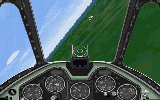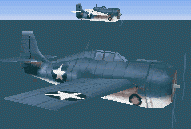
1942 The Pacific Air War
Flying Singer recalls
2000
Missions were historically based -- you might be flying a CAP over Henderson Field, Guadalcanal, or defending the USS Enterprise, or dive bombing the IJN carriers at the Battle of Midway. Careers started in the planes appropriate to the year of the war (e.g. F4F in 1942) -- if you survived, you could move up to the Hellcat when it became available.

The cockpits pushed the state of VGA art.
Aircraft carrier operations were modeled quite well -- you might have to wait behind a lot of other planes to take off, and landings could be tough, especially in the heavier aircraft.

Hellcat
Graphics were very good for 1994, but limited to 320 x 200 pixels. The planes were shaded and could look really good in external views. A virtual cockpit and a simple padlock view were implemented.
Missions were recorded and could be played back and edited, and you could jump back and fly from any point in the recording.

The final "Gold" version added multimedia elements -- film clips, diagrams, tactics, etc. The game also included a map-based "strategic" component -- a game within a game in which you controlled the carriers, sending out scouts and launching attacks when you found the enemy. This was not a full naval warfare simulation, but it was pretty good (I believe you could jump in and fly from this module too, something like the AWACS module in Total Air War).
PAW included "remote play" by modem, with cooperative or head-to-head options. PAW was DOS-based and ran OK on a 486/66, and quite well on a P90. It did a great job in evoking the mood and tension of the war in 1942, when the USN started on the defensive and fought its way to air dominance.

The explosions were nicely detailed
One strange thing about the F4F Wildcat was that Grumman decided to save weight and complexity by having the gear retract manually (they dropped by gravity).
There was a small crank on the left side of the cockpit, on or near the floor. It required something like 20 turns on a VERY stiff crank to get them up. I assume it was some sort of ratchet mechanism, but if you released it at the wrong time, it could catch your hand and break fingers!
You could always tell when the pilot was cranking up the gear -- the plane's nose would bob up and down (wonder why they just didn't press the G key?).
Of course they would also be flying formation at the time. Those guys had some amazing skills!
The F6F had hydraulic landing gear and a lot more power -- when F4F pilots got those planes in 1943 they thought they were in heaven!
tagPacific Theatre WWII
tagCarrier